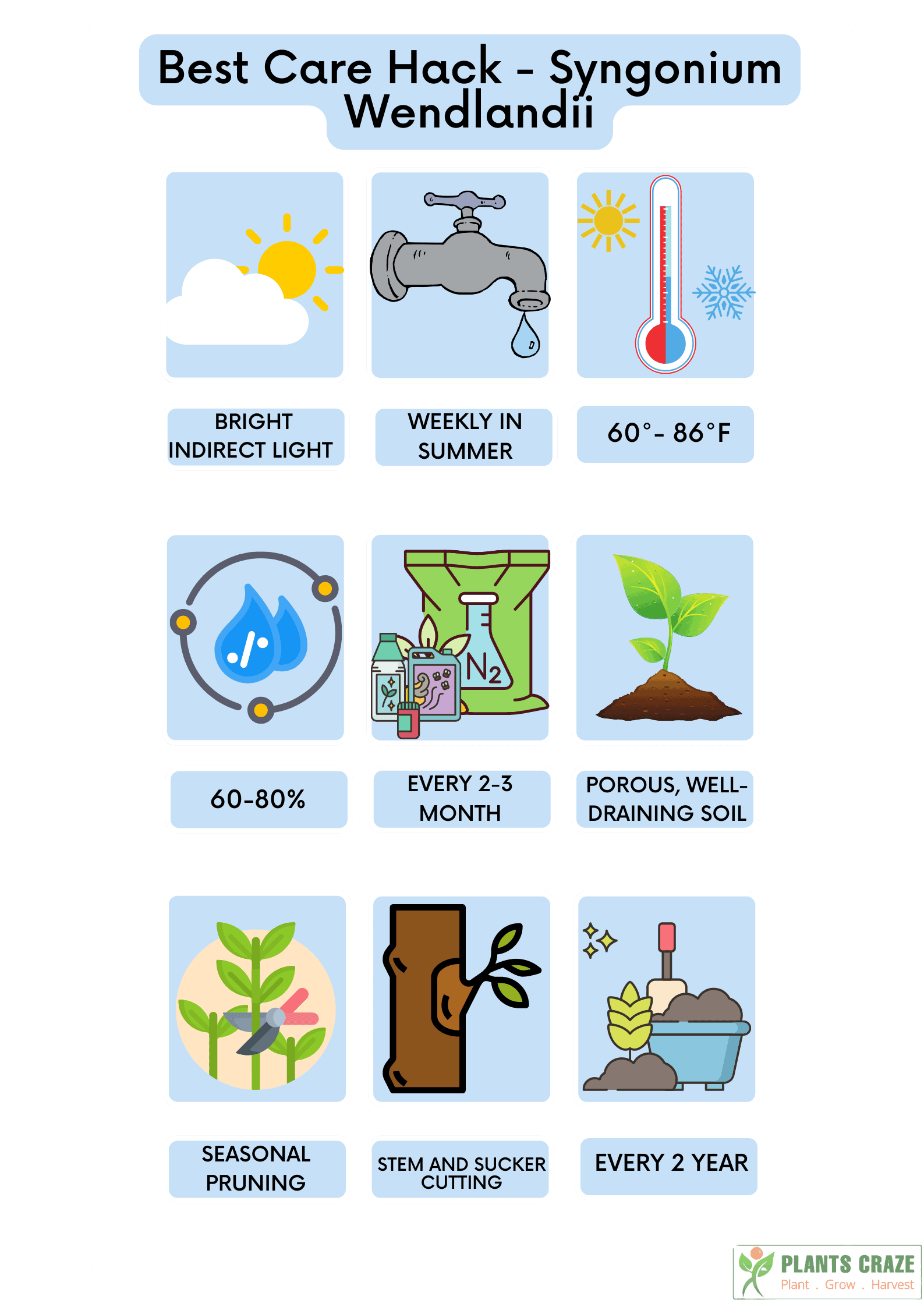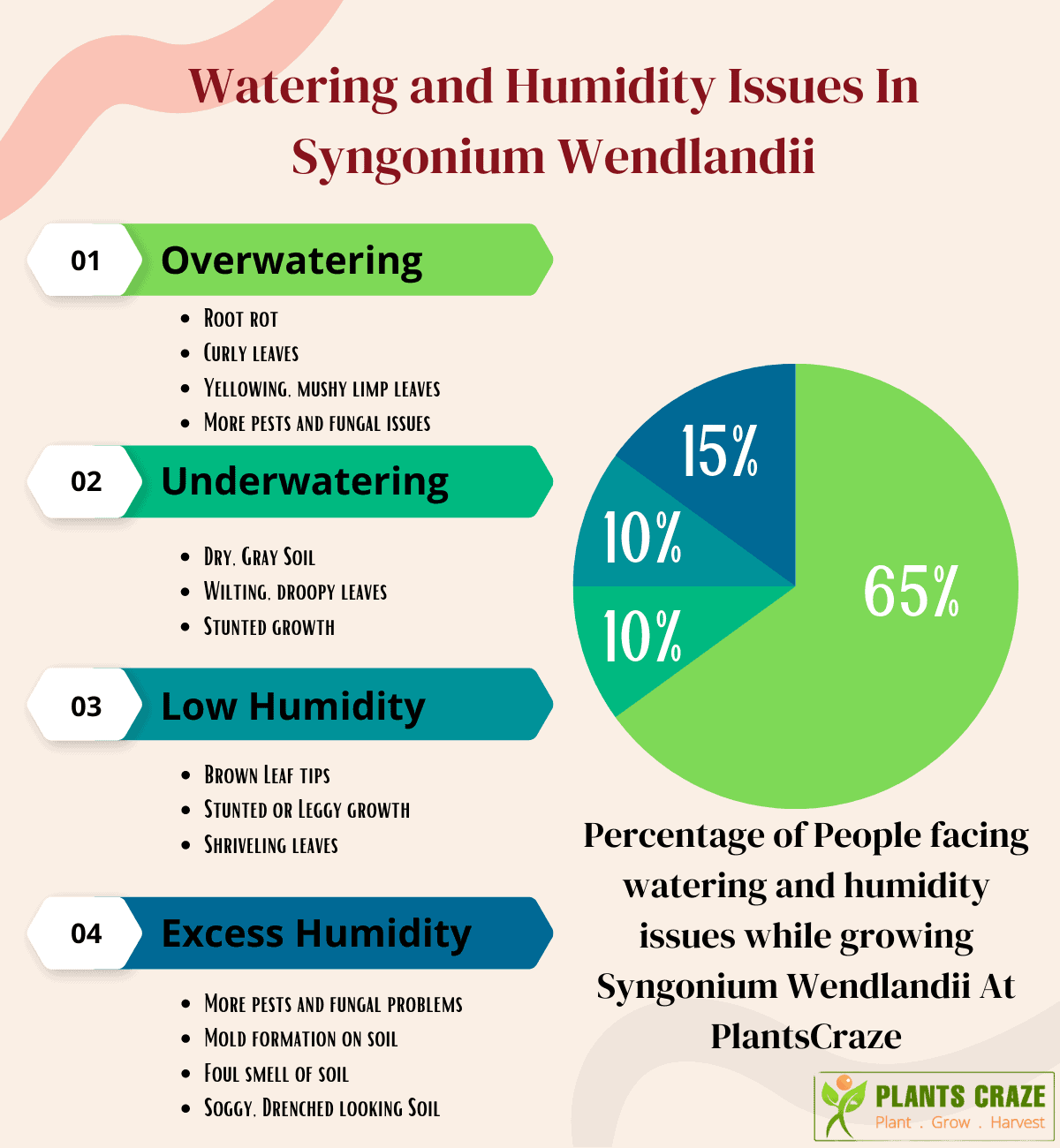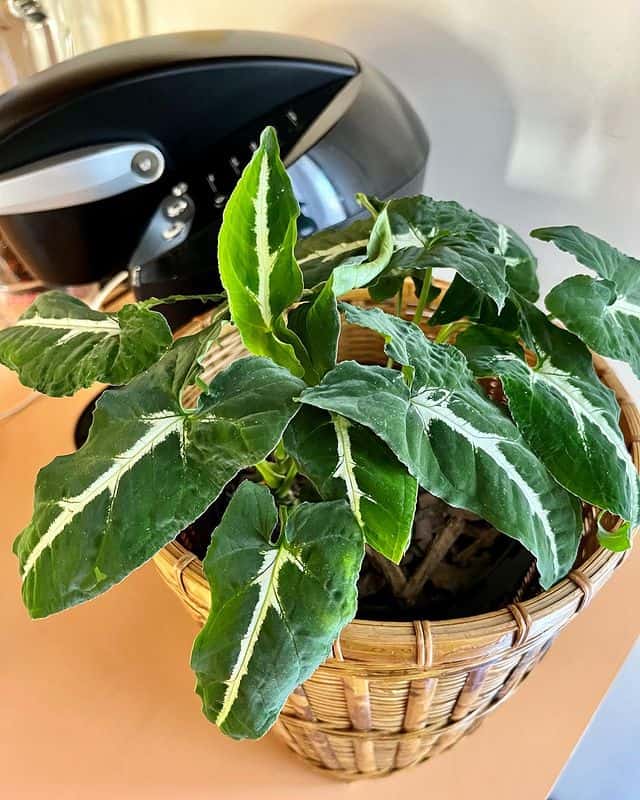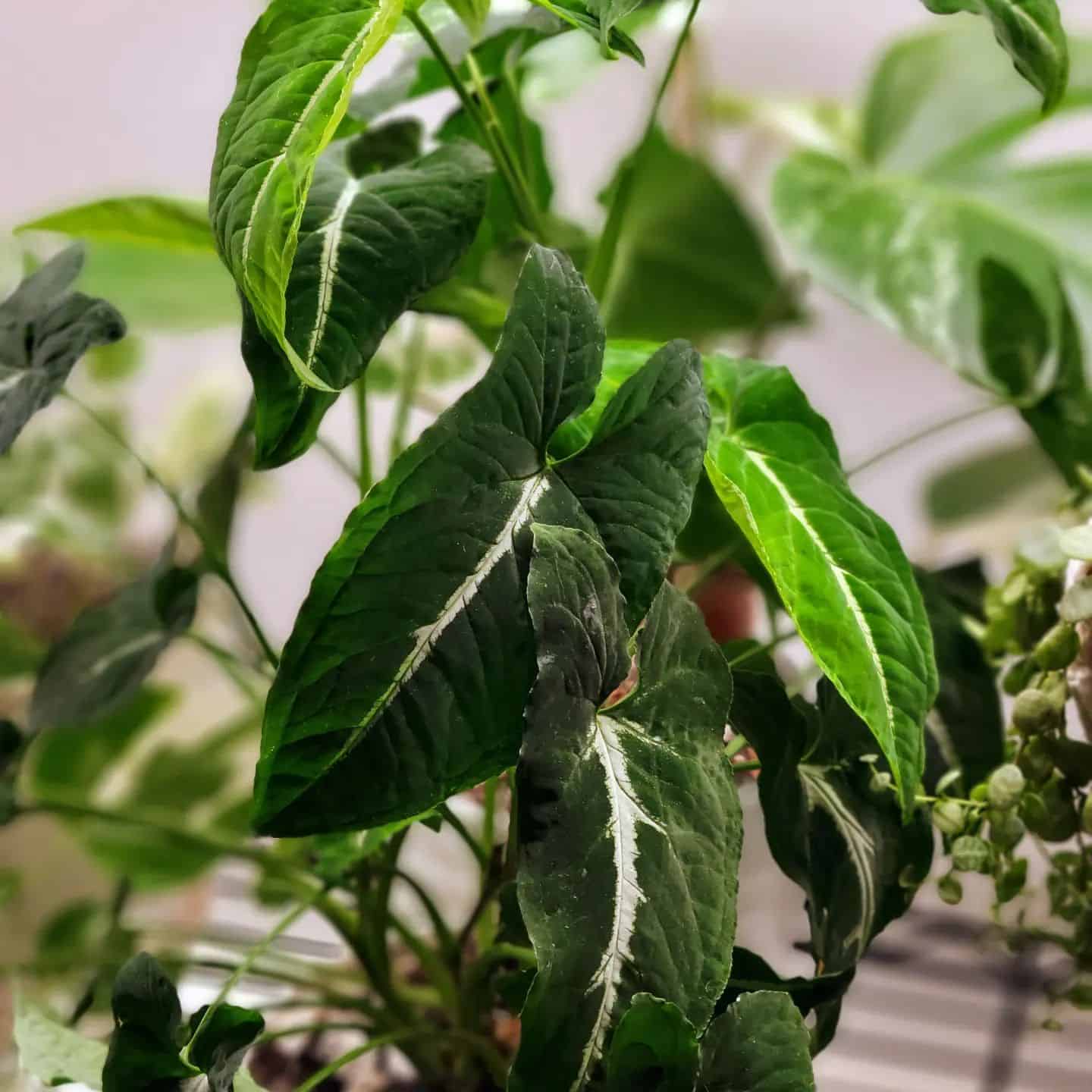Famous for variegated leaves, Syngonium wendlandii offers excellent air purifying benefits, but not when they are sick due to poor care.
But that is not all you can do to keep your wendlandii Syngonium happy and thriving, so stick with the article till the end!
Table of Contents Show
Overview of Syngonium Wendlandii
Syngonium wendlandii is also known as the ‘Silver Goossefoot plant’ due to goose feet-shaped young leaves.
Let’s have a quick look at the overview of the plant.
| Indicator | Identity |
|---|---|
| Scientific Name | Syngonium wendlandii |
| Common Name | Silver Goosefoot Plant Arrowhead Plant |
| Status and Ecology | Life Cycle: Perennial Habit: Climber USDA Zones: 11-12 Native Zone: Mexico and Central America |
| Growth Rate | Slow to Modest |
| Plant Height | Maximum height 5 feet 2 feet width within 5-10 years. |
| Leaf | Shape: Arrow-shaped Color: Velvety green with silver variegation Texture: Glossy |
| Blooms | Creamy white flowers with green hood like spathe. Blooming Period March to May |
| Toxicity | Toxic to humans, dogs and cats. |
A Complete Care Guide for Syngonium Wendlandii
Like any other tropical plant, wendlandii prefers a moist, warm environment for optimal growth and development.
Have a look at the requirements and their optimal conditions for the plant.

1. Sunlight & Temperature
Syngonium wendlandii prefers indirect bright sunlight at a warm temperature ranging from 60 to 86°F.
Under improper lighting and temperature, they exhibit various telltale signs.
Extreme Light and Temperature: Scorched, yellowing, brown spots, curly leaf tips, and margin
Low Light and Cold Temperature(<50°F): Fading variegation, curling leaves, leggy or stunted growth, yellowing, droopy leaves
Aim for incandescent lamps, heat pads, and frost blankets to avoid such conditions.
Also, avoid placing Syngonium near air vents, AC, or radiators to lower temperature stress.
2. Watering & Humidity
Like other arrowhead varieties, Syngonium wendlandii prefers to stay moist with humidity at 60-80% as in its natural habitat.
But cut back watering in winter up to twice a month to avoid overwatering issues.

Aim for a bottom-watering approach with some pebbles on to keep Syngonium hydrated.
That said, occasionally offer them an overhead shower to wash away any salt build-ups.
Also, use a moisture meter or chopsticks to check whether it is time to water wendlandii.
3. Soil & Fertilizer
Syngonium thrives in well-draining soil of moderate water retention enriched with organic matter.
However, you can use a diluted liquid fertilizer every two weeks during the active growing season.
But refrain from fertilizing them in winter or perhaps once in the whole dormant season.
Remember, too much fertilizer does not boost plant growth. Instead, they result in a chemical burn, root rot, and brown spots.
Contrarily, under fertilized wendlandii, appears weak with no new growth alongside yellow leaves.
4. Potting and Repotting
Syngonium wendlandii won’t make a fuss even when kept in a 4″ to 6″ clay pot. But they need immediate repotting once they outgrow the pot.
Furthermore, repotting could be the only way to salvage when Syngonium is infected with fungal diseases.
Fungal diseases of Syngonium wendlandii are bacterial blight, leaf spot, and stem rot.

Under such peril, report your wendlandii using fresh potting mix after trimming infected parts and applying fungicides.
Otherwise, repot them every two years in early spring in a 2″ bigger pot than the current one to ensure no rootbound.
5. Seasonal Pruning
Despite Syngonium wendlandii being a low-maintenance plant, they may require subtle pruning to keep them in shape.
Aim to prune their damaged, decaying parts in early spring to ensure optimal growth of wendlandii.
But remember not to snip off aerial roots or runners to avoid any resulting pruning stress.
Meanwhile, pruning is essential to treat and control pest infestation in wendlandii.
In such peril, prune pest-infected parts using sterilized pruners and safely dispose of them.
As prevention, you can apply neem oil and regularly keep the plant leaves clean using soapy water.
Growth Rate of Syngonium Wendlandii
Syngonium wendlandii is a tropical vine popular among the Chinese community with a belief they bring good luck.
Spring and summer is the active growing season for Syngonium, while winter is when they undergo dormancy.
Although they appear compact in their juvenile stage, they get big after maturing. So, aim to stake them as in Monstera staking.

The plant has broad variegated glossy dark leaves and is mainly grown for its silver-white marking over its veins. But they fade after the Syngonium wendlandii mature similar to Pink Syngonium.
Although they rarely bloom indoors, they produce small, creamy white inflorescence wrapped with a green spathe in wild.
Once they mature, they will most likely bloom in spring when kept outdoors with ideal Syngonium wendlandii care.
Toxicity of Syngonium Wendlandii
According to the ASPCA, Syngonium wendlandii is toxic to cats, dogs, and even horses.
If ingested, they can cause swelling, oral irritation, vomiting, diarrhea, and upset stomach.
However, the symptoms may get severe when consumed in large amounts resulting in kidney failure.
Similarly, consuming the plant can cause hypersalivation, allergy, and mouth ulceration in pets.
Thus, take proper caution and preventive measures to protect Syngonium from pets and kids.
Some hotlines you can rely on if you suspect your kids or pets are eating Syngonium.
- American Poison Control Center: (888) 426-4435
- Pet poison helpline: (855) 764-7661
They are not harmful to the touch, and symptoms appear only after ingestion.
Propagation Methods for Syngonium Wendlandii
The ideal time to propagate the plant is early summer or spring before active growth.
However, the sucker-cutting method is preferred due to its easy steps and higher success rate.
Before you make your hands dirty, gather tools like sterilized pruners, fresh soil mix, and rooting hormones.
1. Propagation Via Stem Cuttings
Select a healthy stem without any visible signs of diseases or pests and remove leaves, leaving a pair on top.
- Plant the cutting in fresh potting mix.
- Cover the pot using transparent plastic to mimic a mini greenhouse.
- Poke a few holes in it to ensure optimal air circulation.
- Place the plant in a sunny location that receives indirect lighting.
- Maintain temperature at 64°F for optimal conducive temperature.
Within two months, the cuttings should have established a firm root.
Once they outgrow the pot, you can transplant them into a bigger pot using a fresh soil mix.
2. Propagation Via Sucker Cuttings
Look for healthy roots and take a 4″ sucker cutting, ensuring they have roots attached.
- Place the cutting, ensuring the cut ends are touching the water.
- Replace the water every few days to avoid bacterial growth.
- Mimic a mini greenhouse via plastic bag and poke holes for air.
- Place the plant in a sunny location that receives indirect lighting.
Once they have legit new root sprouts, you can transplant them into a new container with fresh soil mix.
After that, proceed with regular Syngonium wendlandii care, as I have mentioned above.
FAQs About Syngonium Wendlandii
Is Syngonium wendlandii a climber?
Yes, the iconic arrowhead Syngonium wendlandii is a climber that climbs up using its aerial roots.
What is Syngonium rayii vs. wendlandii?
Although they have identical arrow-shaped foliage, rayii has dark green leaves, while wendlandii has comparatively lighter green leaves.
Moreover, the wendlandii has more elongated broader leaves than rayii.
Wrapping Up…
Keep your Syngonium wendlandii healthy by providing proper sunlight and uniform water to grab all benefits they offer.
Remember to gather your wendlandii alongside plants like Areca palm to maintain humidity at optimal levels naturally.
Good Luck!


